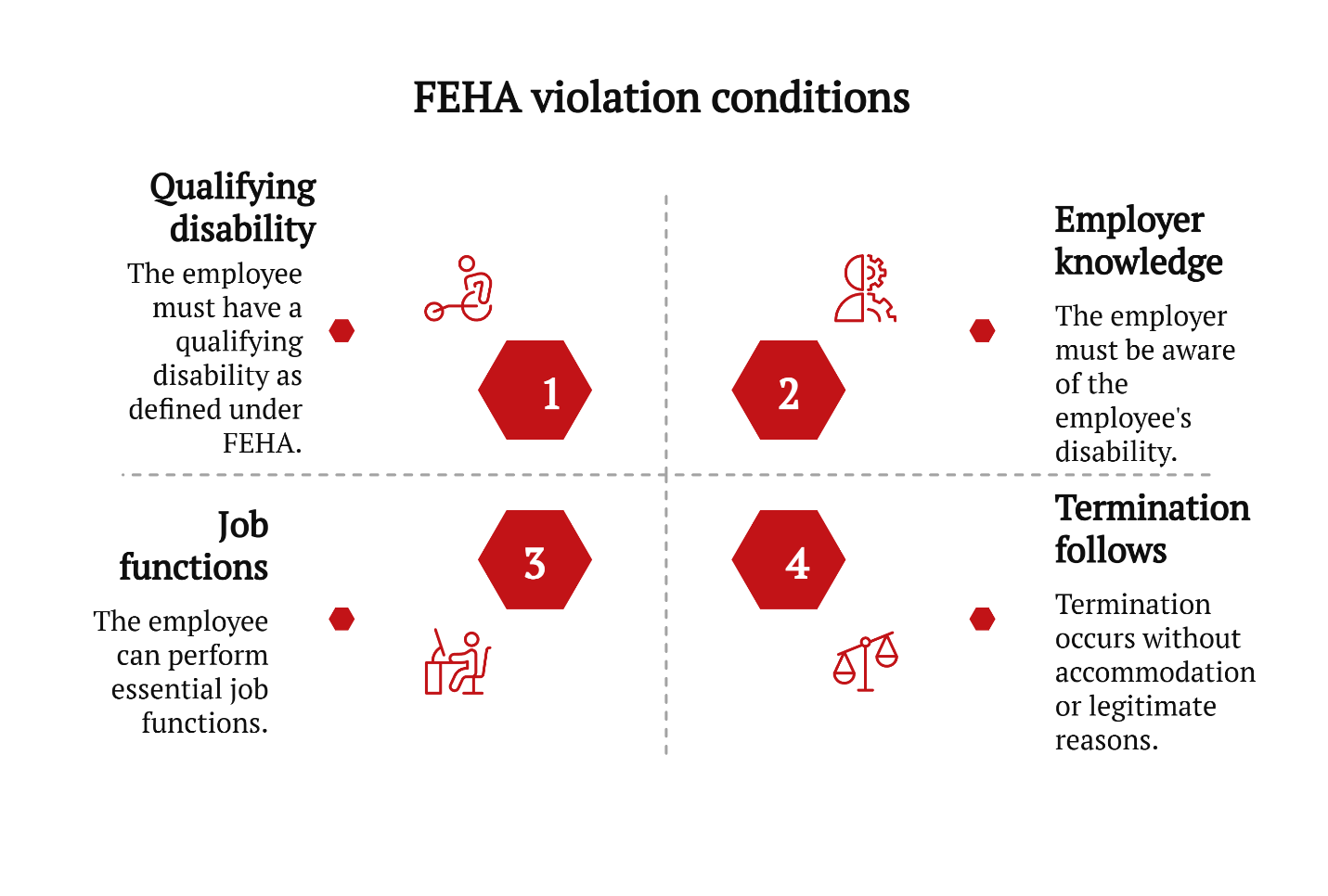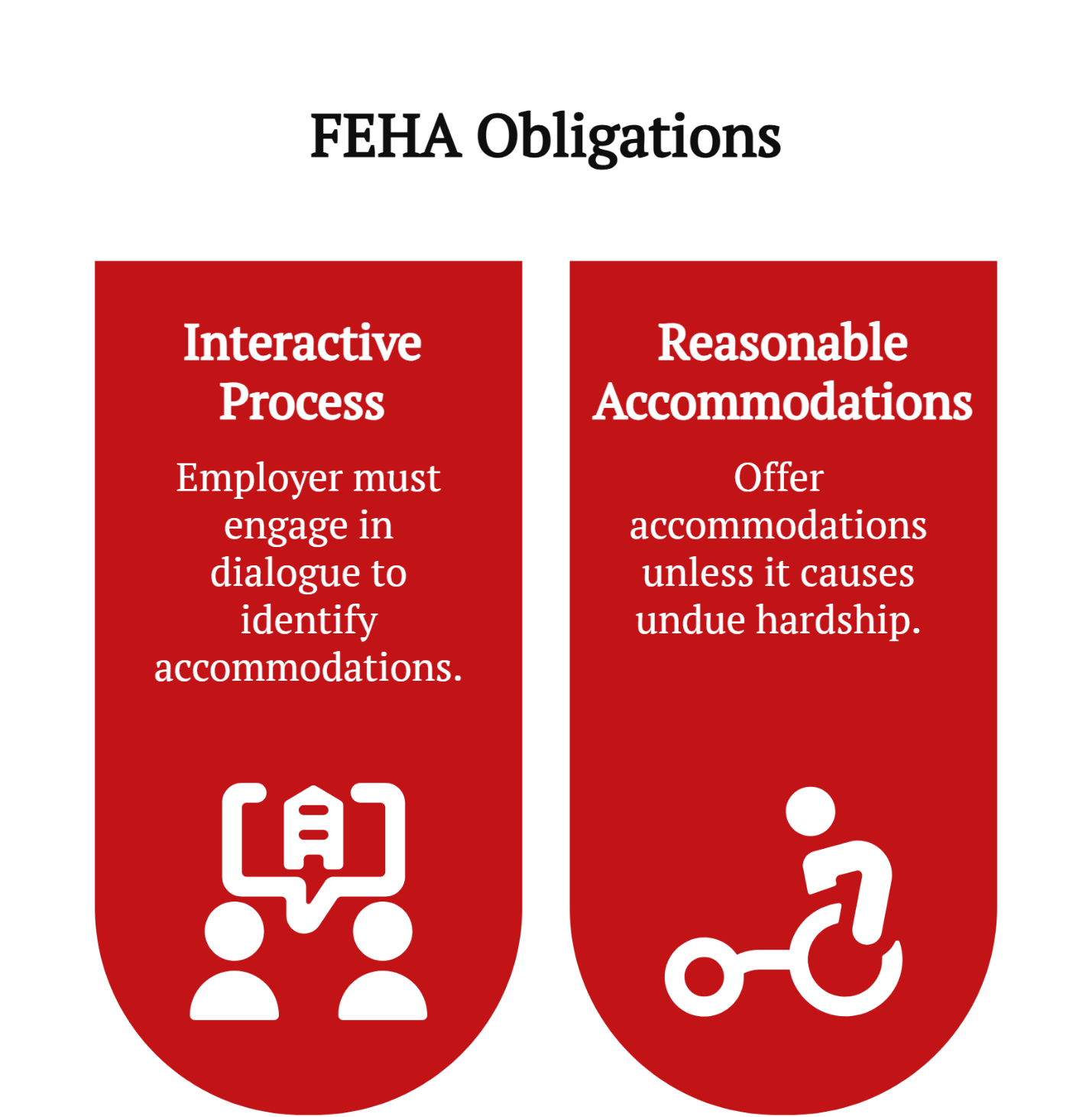📌 Key Takeaways
Termination After a Diabetes Disclosure May Raise Statutory Concerns:
Under California’s Fair Employment and Housing Act (FEHA), termination that closely follows the disclosure of a protected medical condition—such as diabetes—may suggest a potential statutory violation, particularly if it occurs without an interactive process or reasonable accommodation.
Employers Must Engage in a Good Faith Interactive Process:
California law requires employers to participate in a timely, good faith interactive process once they are made aware of an employee’s protected condition. Failure to do so may constitute a FEHA violation, even if the termination is not explicitly linked to the condition.
Reasonable Accommodation Obligations Are Legally Mandated:
Employers are obligated to offer reasonable accommodation unless they can show that doing so would create an undue hardship. Accommodation for diabetes may include schedule modifications, break flexibility, or task adjustments, and ignoring these requirements may be a breach of statutory duties.
Certain Patterns May Signal Non-Compliance with FEHA:
Indicators such as the absence of accommodation discussions, sudden negative performance reviews, or inconsistent application of policies following disclosure may suggest procedural or discriminatory failures under California law.
Legal Remedies May Be Available, But Depend on Proven Violations:
If a FEHA violation is established, statutory remedies may include compensation, reinstatement, injunctive relief, and attorney’s fees. However, determining whether a violation occurred is fact-specific and must be evaluated in context.
Understanding these foundational principles helps individuals assess whether a termination may involve statutory concerns under FEHA. This summary is for informational purposes only and does not constitute legal advice. For case-specific evaluation, consult a qualified California employment attorney.
If an employee in California is terminated shortly after disclosing a diabetes diagnosis, questions may arise about whether that termination violated the Fair Employment and Housing Act (FEHA). Under California law, diabetes is generally considered a protected medical condition, and employers are subject to specific legal obligations when that condition is disclosed. Recognizing the difference between a lawful termination and a statutory violation is critical for anyone navigating the aftermath of sudden job loss.
This article outlines how FEHA addresses terminations connected to protected conditions like diabetes and highlights the key legal standards used to evaluate whether a statutory violation may have occurred.
Understanding California’s Statutory Framework for Disability-Based Termination

FEHA prohibits employment discrimination based on disability, including medical conditions such as diabetes. Under this statute, termination may constitute a wrongful termination if it is substantially motivated by the employee’s protected medical status.
A potential FEHA violation may exist when:
- The employee has a qualifying disability under FEHA
- The employer has knowledge of the disability
- The employee is capable of performing essential job functions, with or without reasonable accommodation
- The termination follows the disclosure without evidence of accommodation efforts or legitimate, non-discriminatory reasons
The law does not require that discriminatory intent be overt. A causal connection between the protected condition and the termination decision may support a finding of a statutory violation, particularly where the timing and employer conduct create an inference of discrimination.
FEHA Obligations Following Disclosure of a Protected Medical Condition

When an employee discloses a disability such as diabetes, the employer must meet specific statutory duties. A failure to meet these duties—especially when followed by termination—may raise concerns about procedural and substantive non-compliance with California law.
Key legal requirements include, but are not limited to:
- Engagement in the Interactive Process: Once informed of the medical condition, the employer must engage in a timely, good faith dialogue to identify feasible accommodations. This process is mandatory and cannot be ignored or delayed.
- Provision of Reasonable Accommodations: FEHA requires that reasonable accommodations be offered unless doing so would result in an undue hardship. In the context of diabetes, this might involve flexible work schedules, additional breaks, or modified duties.
The absence of an interactive process or accommodation attempt—especially when followed by termination—may be viewed as a FEHA violation.
Identifying Red Flags That May Suggest a Statutory Violation
While each employment situation is unique, certain patterns may signal a departure from FEHA compliance. Identifying these indicators can help individuals understand whether their rights under California law may have been compromised.
Common red flags may include:
- Termination that closely follows the disclosure of a protected condition
- Sudden negative performance evaluations without prior notice or documentation
- Lack of an interactive process
- Policies applied inconsistently or selectively to affected employees
The law concerns the totality of the circumstances, including employer conduct, timing, and the nature of the termination. While these indicators do not automatically confirm a violation, they may suggest the need for legal evaluation.
Legal determinations depend on the specific facts of each case. This content does not assess any individual employment scenario.
Statutory Remedies Under FEHA for Violation-Based Termination
FEHA provides specific legal remedies where a wrongful termination is proven under its statutory framework. These remedies are designed to redress harms suffered due to an employer’s violation of the law.
Remedies may include:
- Compensation for lost wages and benefits
- Compensation for emotional distress
- Reinstatement, where appropriate
- Injunctive or declaratory relief
- Attorney’s fees and costs in successful claims
It is important to note that the availability of remedies is determined by the trier of fact based on the merits of each case. Identifying a statutory violation is the first step before any legal remedy becomes available.
Conclusion
California law under FEHA establishes clear protections for employees with disabilities, including those managing diabetes. When a termination follows the disclosure of a protected medical condition, and when the employer fails to engage in the legally required accommodation process, questions about the lawfulness of that termination may arise.
While not all terminations amount to statutory violations, certain patterns—such as lack of accommodation efforts or abrupt job loss post-disclosure—may warrant further analysis. Due to the complexity of California employment law and the fact-specific nature of these claims, seeking qualified legal guidance is often necessary to assess potential violations.
Laws and interpretations evolve. For current legal guidance tailored to individual facts, consult a licensed California employment law attorney.
Frequently Asked Questions
What makes a termination a violation of California law under FEHA when diabetes is involved?
A termination may violate FEHA if it occurs because of the employee’s protected medical condition, particularly when there is no evidence the employer engaged in the required interactive process or offered reasonable accommodation, after the employee requested the same. California law focuses on whether the disability was a substantial motivating reason for the employer’s decision.
When is it appropriate to consult a California employment attorney regarding possible FEHA violations?
The short answer is as soon as possible. Legal consultation is recommended when a termination closely follows disclosure of a protected condition and the employer failed to initiate an accommodation process. Because FEHA claims depend heavily on facts and timing, professional evaluation is often critical to identify whether a legal violation occurred.
Frequently Unasked Questions
How does timing affect the identification of a FEHA-based wrongful termination?
The proximity of termination to the disclosure of a protected condition may raise a legal inference of discrimination. Timing is not determinative on its own but can be a relevant factor when paired with other evidence such as lack of accommodation efforts or inconsistent employer behavior.
Why is the interactive process central to identifying potential wrongful termination under FEHA?
Under California law, the interactive process is a statutory obligation, not a courtesy. If an employer fails to engage in good faith discussions about possible accommodations after becoming aware of a condition like diabetes, and instead proceeds directly to termination, that failure may constitute a procedural violation of FEHA.
Disclaimer:
This content is for informational purposes only. This content is not legal advice. No attorney-client relationship is formed through this content. Please consult a qualified attorney in your jurisdiction for legal advice specific to your situation.
Protect Your Rights | The Akopyan Law Firm, A.P.C. | Top Gun Employment Lawyers
Have you been wrongfully terminated from your job? Have you suffered discrimination, harassment, or retaliation in the workplace? Has your employer violated wage and hour laws? If so, we can help. The Akopyan Law Firm, A.P.C. is dedicated to protecting and enforcing employees’ rights throughout Southern California. With a 97% success rate and millions recovered for our clients, our team of experienced and talented employment lawyers can fight to secure the justice you deserve.
Take the First Step Towards Securing Justice: Call us today to speak with one of our experienced employment lawyers. The firm offers case evaluations free of charge.
Contact Us Today:
- Phone: (818) 509-9975
- Office Locations: Los Angeles, Bakersfield, Costa Mesa, Temecula, Rancho Cucamonga, Oxnard, Culver City, and San Diego in California.
Important: Contacting the Akopyan Law Firm, A.P.C. does not create an attorney-client relationship, but all communications will remain private and confidential. Each case is unique. The Akopyan Law Firm, A.P.C., does not guarantee any outcome.

